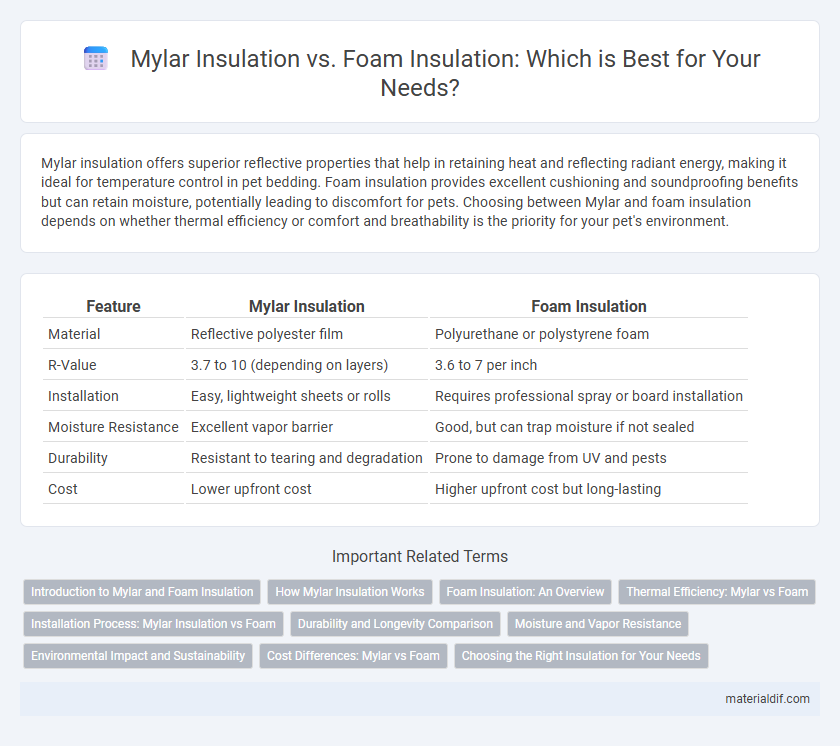Mylar insulation offers superior reflective properties that help in retaining heat and reflecting radiant energy, making it ideal for temperature control in pet bedding. Foam insulation provides excellent cushioning and soundproofing benefits but can retain moisture, potentially leading to discomfort for pets. Choosing between Mylar and foam insulation depends on whether thermal efficiency or comfort and breathability is the priority for your pet's environment.
Table of Comparison
| Feature | Mylar Insulation | Foam Insulation |
|---|---|---|
| Material | Reflective polyester film | Polyurethane or polystyrene foam |
| R-Value | 3.7 to 10 (depending on layers) | 3.6 to 7 per inch |
| Installation | Easy, lightweight sheets or rolls | Requires professional spray or board installation |
| Moisture Resistance | Excellent vapor barrier | Good, but can trap moisture if not sealed |
| Durability | Resistant to tearing and degradation | Prone to damage from UV and pests |
| Cost | Lower upfront cost | Higher upfront cost but long-lasting |
Introduction to Mylar and Foam Insulation
Mylar insulation consists of a reflective polyester film that effectively reduces radiant heat transfer, making it ideal for temperature regulation in attics and walls. Foam insulation, available in types such as spray foam and rigid foam boards, provides excellent thermal resistance and air sealing properties by expanding and filling gaps. Both materials serve distinct roles in energy efficiency, with Mylar focusing on reflecting heat and foam insulation emphasizing heat retention and air barrier functions.
How Mylar Insulation Works
Mylar insulation works by reflecting radiant heat due to its highly reflective metallic surface, reducing heat transfer through radiation. Unlike foam insulation, which relies on trapping air to minimize conductive and convective heat loss, Mylar creates a radiant barrier that effectively lowers heat gain and loss in spaces such as attics and walls. This reflective property makes Mylar insulation particularly effective in hot climates or applications where controlling radiant heat is crucial.
Foam Insulation: An Overview
Foam insulation provides superior thermal resistance with R-values typically ranging from 3.6 to 7 per inch, making it highly effective for energy efficiency in residential and commercial buildings. It offers excellent air sealing properties, reducing drafts and moisture infiltration, which enhances indoor comfort and prevents mold growth. Compared to Mylar insulation, foam insulation also provides structural support and greater durability in various environmental conditions.
Thermal Efficiency: Mylar vs Foam
Mylar insulation offers superior thermal efficiency by reflecting up to 97% of radiant heat, significantly reducing heat transfer compared to foam insulation, which primarily slows conductive heat flow. Foam insulation provides effective resistance to heat conduction with R-values typically ranging from 3.5 to 7 per inch, but lacks Mylar's radiant heat reflection capabilities. Combining Mylar with foam insulation can maximize thermal efficiency by addressing both radiant and conductive heat transfer.
Installation Process: Mylar Insulation vs Foam
Mylar insulation features a straightforward installation process, typically involving unrolling and securing reflective sheets between studs or rafters, making it quicker and less labor-intensive compared to foam insulation. Foam insulation requires professional application through spraying or injecting, which creates an airtight seal but demands specialized equipment and longer curing time. The ease of installation of Mylar makes it suitable for DIY projects, whereas foam insulation provides superior thermal performance with a more complex, time-consuming setup.
Durability and Longevity Comparison
Mylar insulation exhibits superior durability compared to foam insulation due to its resistance to moisture, mildew, and temperature fluctuations, ensuring long-lasting performance. Foam insulation can degrade over time when exposed to humidity and UV rays, potentially losing its insulating properties. The reflective properties of Mylar maintain effectiveness for decades, making it a more reliable choice for sustained thermal insulation.
Moisture and Vapor Resistance
Mylar insulation offers superior moisture and vapor resistance due to its reflective polyester film, which effectively blocks water vapor transmission and reduces condensation buildup. Foam insulation, such as closed-cell spray foam, also provides excellent moisture barrier properties but can be more susceptible to water absorption if improperly installed or damaged. When prioritizing moisture control, Mylar insulation maintains long-term vapor resistance without degrading, making it ideal for environments with high humidity.
Environmental Impact and Sustainability
Mylar insulation offers a reflective barrier that minimizes heat transfer and is often recyclable, reducing its environmental footprint compared to foam insulation, which typically relies on petroleum-based chemicals and can emit harmful VOCs during production and disposal. Foam insulation generally has a higher global warming potential due to the use of blowing agents like HFCs, whereas Mylar's thin, durable film contributes less to landfill waste and often contains fewer toxic substances. Choosing Mylar insulation supports sustainability goals by promoting energy efficiency and recyclability, contrasting with foam insulation's challenges related to non-biodegradability and chemical off-gassing.
Cost Differences: Mylar vs Foam
Mylar insulation typically costs less per square foot compared to foam insulation, making it a budget-friendly choice for reflective heat barriers. Foam insulation, such as spray foam or rigid foam boards, tends to have higher upfront costs due to material expenses and application requirements but offers superior thermal resistance (R-value). Despite the higher initial investment, foam insulation's energy savings can offset costs over time, while Mylar insulation provides an economical option for improving energy efficiency in moderate climates.
Choosing the Right Insulation for Your Needs
Mylar insulation offers superior radiant heat reflection and is lightweight, making it ideal for applications requiring moisture resistance and thermal efficiency without added bulk. Foam insulation, such as spray foam or rigid foam boards, provides excellent air sealing and higher R-values per inch, making it suitable for structural areas where airtightness and durability are priorities. Assess factors like climate, installation space, and budget to determine if Mylar's reflective properties or foam's insulation density better align with your project's thermal performance goals.
Mylar Insulation vs Foam Insulation Infographic

 materialdif.com
materialdif.com